Ile Saint Louis Paris
If you wish to enjoy a new distinctive Parisian lifestyle & desire to book an apartment on Ile Saint Louis for your next vacation stay, Guest Apartment Services Paris propose offers a collection of selected apartments with personalized services (maid service, concierge and limousine transfers).
Introduction
Winding its timeless way through France, the river Seine has created a unique treasure in the centre of Paris. The Ile Saint Louis is one of two islands at the heart of the City of Lights. Between the Right and Left Bank, it’s situated within easy reach of all of the city’s varied sights and attractions.
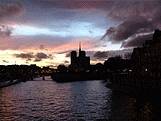 Once owned by the canons of Notre Dame of Paris, the ile was originally named Ile Notre Dame; Uninhabited, it was left in its natural state until the early XVIIth century. It is known that Louis IX (Saint Louis) often came here to read and pray, away from the crowds of the court on the Isle de la Cité. Here he dubbed his knights as well as his son Philippe the Hardy. The Ile Saint Louis was the departure point of the VIIIth Crusade.
Once owned by the canons of Notre Dame of Paris, the ile was originally named Ile Notre Dame; Uninhabited, it was left in its natural state until the early XVIIth century. It is known that Louis IX (Saint Louis) often came here to read and pray, away from the crowds of the court on the Isle de la Cité. Here he dubbed his knights as well as his son Philippe the Hardy. The Ile Saint Louis was the departure point of the VIIIth Crusade.
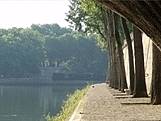 During the reign of his grandson Philippe le Bel, it was used for jousting tournaments and magnificent royal celebrations, More often, however, the island was frequented by those looking for solitary promenades in a quiet place.
During the reign of his grandson Philippe le Bel, it was used for jousting tournaments and magnificent royal celebrations, More often, however, the island was frequented by those looking for solitary promenades in a quiet place.
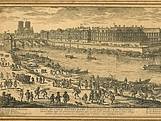 At the beginning of the XVIIth century Ile Saint-Louis had begun to be urbanized according to plans approved by Louis XIII and Marie de Medicis. Slowly and with great care it was constructed . By 1660 most of the work had been completed. Artisans, merchants, entrepreneurs and workers lived along the two main thoroughfares, whereas the quays attracted the aristocracy and wealthy bourgeoisie. Louis Le Vau, the architect of Versailles, constructed there for the ” noblesse ” some of the most ambitious and luxurious mansions of the time. The interiors were adorned with such art as only Designers Le Brun and Le Sueur could create.
At the beginning of the XVIIth century Ile Saint-Louis had begun to be urbanized according to plans approved by Louis XIII and Marie de Medicis. Slowly and with great care it was constructed . By 1660 most of the work had been completed. Artisans, merchants, entrepreneurs and workers lived along the two main thoroughfares, whereas the quays attracted the aristocracy and wealthy bourgeoisie. Louis Le Vau, the architect of Versailles, constructed there for the ” noblesse ” some of the most ambitious and luxurious mansions of the time. The interiors were adorned with such art as only Designers Le Brun and Le Sueur could create.
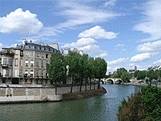 Today this privileged location, rich by its architecture, keeps almost intact the imprint of the late French Renaissance period. A very unique setting has been maintained of which the inhabitants of Paris are very proud. The isle is a retreat from the stress and motion of the modern city.
Today this privileged location, rich by its architecture, keeps almost intact the imprint of the late French Renaissance period. A very unique setting has been maintained of which the inhabitants of Paris are very proud. The isle is a retreat from the stress and motion of the modern city.
Passing its small streets lined boutiques, art galleries, restaurants, strolling its poplar-shaded quays bordered with noble facades, you will inevitably succumb to the charm of this ” Enchanted Isle “.
History
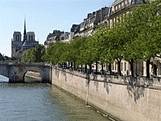 Historically, the Ile Saint Louis is Paris itself, for it was here that the ancient Celtic settlement Parisii, was founded by boatmen and traders, in about 250 BC. With the arrival of Julius Caesar in 52BC and the conquest of Gaul, the Romans founded the city they called Lutetia – the City of Light – on the Mont Sainte Geneviève on the left bank, leaving the Ile Saint Louis and the neighbouring Île de la Cité deserted.
Historically, the Ile Saint Louis is Paris itself, for it was here that the ancient Celtic settlement Parisii, was founded by boatmen and traders, in about 250 BC. With the arrival of Julius Caesar in 52BC and the conquest of Gaul, the Romans founded the city they called Lutetia – the City of Light – on the Mont Sainte Geneviève on the left bank, leaving the Ile Saint Louis and the neighbouring Île de la Cité deserted.
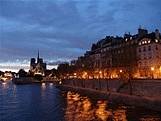 From this time, until the the late 16th century, the Ile Saint Louis island remained uninhabited, and unloved by the Paris Royal Court, which occupied the Louvre – then the palace of the King – and the Île de la Cité on which Notre Dame was built in the XIII century. It was King Henri IV, who drafted the plan to urbanise the Ile Saint Louis but in 1610 he was assassinated Ravaillac in 1610, putting an end to the project.
From this time, until the the late 16th century, the Ile Saint Louis island remained uninhabited, and unloved by the Paris Royal Court, which occupied the Louvre – then the palace of the King – and the Île de la Cité on which Notre Dame was built in the XIII century. It was King Henri IV, who drafted the plan to urbanise the Ile Saint Louis but in 1610 he was assassinated Ravaillac in 1610, putting an end to the project.
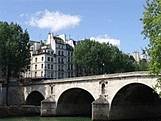
Under the reign of his son, Louis XIII (1610-1643), the plan was resubmitted it the King by what would now be called “property developers”. Their names are to be found in the warren of little streets on the island: Marie gave his name to the Pont Marie, and Poulletier and Le Regrattier have streets named after them.
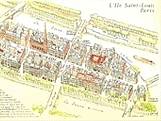 At the time, the island was made up of two islets, the ÎIe Notre-Dame, which belonged to Cathedral, and the ÎIe aux Vaches (Cow Island), which, as its name siuggest was used for grazing market cattle and storing wood. Louis XIII agreed that stone embankments would be erected to shore up the islands and two bridges (the Pont Marie, and the Pont de la Tournelle, which was later rebuilt), and mapped out two street, the Rue Saint-Louis en l’Île and Rue des Deux-Ponts, which have not changed which still form the main axes of the island. In one of the world’s first examples of urban planning, it was mapped and built from end to end during the 17th-century reigns of Henri IV and Louis XIII. Though no architectural style was imposed, the speed of the development and the influence of architect Louis Le Vau resulted in a homogenous and “classical” development. Le Vau was later the architect to the Sun King, Louis XIV and designed the Château de Versailles.
At the time, the island was made up of two islets, the ÎIe Notre-Dame, which belonged to Cathedral, and the ÎIe aux Vaches (Cow Island), which, as its name siuggest was used for grazing market cattle and storing wood. Louis XIII agreed that stone embankments would be erected to shore up the islands and two bridges (the Pont Marie, and the Pont de la Tournelle, which was later rebuilt), and mapped out two street, the Rue Saint-Louis en l’Île and Rue des Deux-Ponts, which have not changed which still form the main axes of the island. In one of the world’s first examples of urban planning, it was mapped and built from end to end during the 17th-century reigns of Henri IV and Louis XIII. Though no architectural style was imposed, the speed of the development and the influence of architect Louis Le Vau resulted in a homogenous and “classical” development. Le Vau was later the architect to the Sun King, Louis XIV and designed the Château de Versailles.
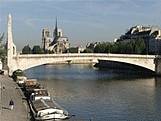 The island today, is almost exactly as it was conceived by its 17th century architects. In the late 19th century, four other bridges were built, connecting the island to Left and Right Banks and to the Île de la Cité and two roads – Rue Jean de and Boulevard Henri IV – opened at the either end. These days, Ile Saint-Louis remains a unique example of the classical Parisian architecture that would flourish in the Grand Siècle. It is a living, breathing, vibrant museum Nine on the buildings are listed “Historic Monuments” and a further twenty-nine others “listed in the Inventory of Historic Buildings” are there to be counted.
The island today, is almost exactly as it was conceived by its 17th century architects. In the late 19th century, four other bridges were built, connecting the island to Left and Right Banks and to the Île de la Cité and two roads – Rue Jean de and Boulevard Henri IV – opened at the either end. These days, Ile Saint-Louis remains a unique example of the classical Parisian architecture that would flourish in the Grand Siècle. It is a living, breathing, vibrant museum Nine on the buildings are listed “Historic Monuments” and a further twenty-nine others “listed in the Inventory of Historic Buildings” are there to be counted.
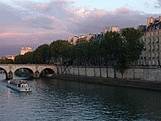 The island was colonised by the people of considerable wealth – who had not, it must be admitted, always come by it honestly. They used their riches to construct some of the finest Hôtels Particuliers – fine mansions which served as townhouses for the nouveau riches. These were hardly mansions in the traditional sense, but sumptuous private residences, designed by the finest architects of the age and decorated by the finest artists. Magnificent examples include the Hôtel de Lauzun on the Quai d’Anjou and the Hôtel Lambert on the corner of the Rue Saint-Louis and the Quai d’Anjou. But the most remarkable of all, unanimously admired by his contemporaries, was the Hôtel de Bretonvilliers the home of Monsieur Le Ragois de Bretonvilliers.
The island was colonised by the people of considerable wealth – who had not, it must be admitted, always come by it honestly. They used their riches to construct some of the finest Hôtels Particuliers – fine mansions which served as townhouses for the nouveau riches. These were hardly mansions in the traditional sense, but sumptuous private residences, designed by the finest architects of the age and decorated by the finest artists. Magnificent examples include the Hôtel de Lauzun on the Quai d’Anjou and the Hôtel Lambert on the corner of the Rue Saint-Louis and the Quai d’Anjou. But the most remarkable of all, unanimously admired by his contemporaries, was the Hôtel de Bretonvilliers the home of Monsieur Le Ragois de Bretonvilliers.
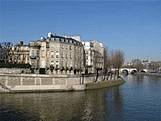 Not content merely to build prestigious houses for themselves, they purchased land next to their new Mansions where they built fine residential property which they rented. One such property, often called “Petit Hôtel de Bretonvilliers”, which we shall speak of later.
Not content merely to build prestigious houses for themselves, they purchased land next to their new Mansions where they built fine residential property which they rented. One such property, often called “Petit Hôtel de Bretonvilliers”, which we shall speak of later.
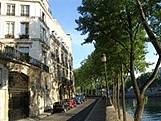 Curiously, in the centuries that followed, the Ile Saint-Louis, so exclusive during the reign of the Sun King and so sought-after today, was deserted by the very nobility who had created it. Its reputation had plummeted so much that, in Marcel Proust’s novel À la recherche du temps perdu his heroine is told that it would be “scandalous” to live there. From the very start, in the 17th century, financiers and magistrates (the Palais de Justice (Law Courts) is on lie de la Cité, close by), men of letters (from the Académie Française, for example), artists and merchants came to live there. But there were also people with working-class backgrounds, like employees, domestic servants, workmen etc. That lasted for a long while and, still in 1950, the sociological/occupational make-up of the island was in line with the average for Paris; people from aIl social backgrounds rubbed shoulders peaceably. To meet the usual needs of its inhabitants, the island offered a large number of small non-luxury shops. It had the reputation of being a peaceful “village”, more talked about than visited.
Curiously, in the centuries that followed, the Ile Saint-Louis, so exclusive during the reign of the Sun King and so sought-after today, was deserted by the very nobility who had created it. Its reputation had plummeted so much that, in Marcel Proust’s novel À la recherche du temps perdu his heroine is told that it would be “scandalous” to live there. From the very start, in the 17th century, financiers and magistrates (the Palais de Justice (Law Courts) is on lie de la Cité, close by), men of letters (from the Académie Française, for example), artists and merchants came to live there. But there were also people with working-class backgrounds, like employees, domestic servants, workmen etc. That lasted for a long while and, still in 1950, the sociological/occupational make-up of the island was in line with the average for Paris; people from aIl social backgrounds rubbed shoulders peaceably. To meet the usual needs of its inhabitants, the island offered a large number of small non-luxury shops. It had the reputation of being a peaceful “village”, more talked about than visited.
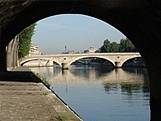 A change in the island’s fortunes occurred in the second half of the 20th century, after the Second World War. The exceptional economic growth during the “Thirty Glorious Years” (1950-1980) and the rise in the standard of living that accompanied it, retored the island to as opulence and splendour it had not seen in three and a half centuries of existence.
A change in the island’s fortunes occurred in the second half of the 20th century, after the Second World War. The exceptional economic growth during the “Thirty Glorious Years” (1950-1980) and the rise in the standard of living that accompanied it, retored the island to as opulence and splendour it had not seen in three and a half centuries of existence.
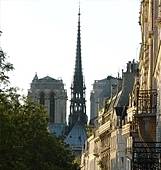 The consequence of enrichment, apparent in every city, was the rise in price per square metre of housing , with a yet more marked increase in price in the central districts of Paris, especially if the property displayed historic and artistic qualities. Thus, whenever people moved away or people inherited the property, tenants or buyers appeared on the scene accepting to pay more in order to find somewhere to live in a prestigious district; many people were forced to leave the island, which had become beyond their means, and had to sell. The newcomers, wealthier and thus older, often retired, settled in big flats without their children, who were married and living elsewhere. It follows from this that the population aged and the numbers diminished: there were about 6100 people towards 1950-60, just as there were at the time of the 1831 census, but only 2900 at the time of the 1999 census. The phenomenon became more pronounced through the purchase of extensive flats by people from aIl over France and from abroad; today, these flats, converted into “second homes” by the buyers, make up almost a quarter of the total number of homes. This “ageing” is accompanied by a sociological change; the humblest categories are shrinking in favour of the upper and middle classes.
The consequence of enrichment, apparent in every city, was the rise in price per square metre of housing , with a yet more marked increase in price in the central districts of Paris, especially if the property displayed historic and artistic qualities. Thus, whenever people moved away or people inherited the property, tenants or buyers appeared on the scene accepting to pay more in order to find somewhere to live in a prestigious district; many people were forced to leave the island, which had become beyond their means, and had to sell. The newcomers, wealthier and thus older, often retired, settled in big flats without their children, who were married and living elsewhere. It follows from this that the population aged and the numbers diminished: there were about 6100 people towards 1950-60, just as there were at the time of the 1831 census, but only 2900 at the time of the 1999 census. The phenomenon became more pronounced through the purchase of extensive flats by people from aIl over France and from abroad; today, these flats, converted into “second homes” by the buyers, make up almost a quarter of the total number of homes. This “ageing” is accompanied by a sociological change; the humblest categories are shrinking in favour of the upper and middle classes.
Ile Saint-Louis Today
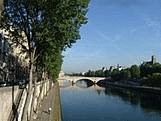 Today the Ile Saint Louis has become a highly residential area and a privileged destination and those looking for a romantic visit or who are impassioned about history looking for a Paris that is both elegant and authentic.
Today the Ile Saint Louis has become a highly residential area and a privileged destination and those looking for a romantic visit or who are impassioned about history looking for a Paris that is both elegant and authentic.
In general, the island retains its reputation as a home for the upper class. The permanent owners tend to be wealthy, comfortably settled, and of an older generation that keeps to itself, observing from a distance. However, while Ile Saint-Louis remains uniquely calm compared to the rest of Paris, it has not all together escaped the rise of tourism, especially in recent years.
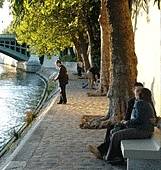 In spring and summertime people from around the world come to explore the tiny shops, the peaceful and romantic quays, and of course the views on the city it has to offer. The most popular attractions are certainly the original (and still functional) site of the famous homemade Berthillon ice cream and the western point of the island near the Pont Saint-Louis which joins the island to the Ile de la Cité. The cafés in this area are often filled to capacity with people-watchers and sight-seers savouring both the view of Notre-Dame and a cone of Berthillon.
In spring and summertime people from around the world come to explore the tiny shops, the peaceful and romantic quays, and of course the views on the city it has to offer. The most popular attractions are certainly the original (and still functional) site of the famous homemade Berthillon ice cream and the western point of the island near the Pont Saint-Louis which joins the island to the Ile de la Cité. The cafés in this area are often filled to capacity with people-watchers and sight-seers savouring both the view of Notre-Dame and a cone of Berthillon.
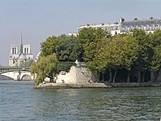 Stairway access leads to the lower, tree-shaded quays. Those that gather there range from musicians, to lovers, to those just reading a book or feeding the ducks that swim close to shore, protected by the island. This attests to the fact that, despite its development, the island has not lost its original function as a place for people to gather and relax in company with the Seine.
Stairway access leads to the lower, tree-shaded quays. Those that gather there range from musicians, to lovers, to those just reading a book or feeding the ducks that swim close to shore, protected by the island. This attests to the fact that, despite its development, the island has not lost its original function as a place for people to gather and relax in company with the Seine.
Whereas the peripheral ring formed by the quays is, in general, home to the numerous 17th century Hôtels Particuliers (noble townhouses), the inner streets, most notably the sort of “main street” running the length of the island called Rue Saint-Louis-en-l’Ile, are host to more commercial venues.
 Throughout its history the island has always been known for its artistic richness. Even today anyone walking down this main street would be overwhelmed by the barrage of artists’ galleries that specialize in anything from sculpture to painting to glass making to handcrafted jewelry. Occasionally you may be lucky and catch a private exhibition.
Throughout its history the island has always been known for its artistic richness. Even today anyone walking down this main street would be overwhelmed by the barrage of artists’ galleries that specialize in anything from sculpture to painting to glass making to handcrafted jewelry. Occasionally you may be lucky and catch a private exhibition.
Small specialty shops play an important part in the commercial atmosphere on Ile Saint-Louis. Artistic clothing stores display their colourful and sprightly creations with pride, as do the toy shops carrying novelties, children’ games, and puppets (especially the magnificent puppet shop “Clair de Rêve”). A handful of bookshops scattered around Ile Saint-Louis invite strollers to peruse their collections on history, archaeology, travel, and Paris’ cultural heritage. And here and there you’ll find shops specializing in goods from regions around the world including East Asia and Tibet.
Food is largely present on Ile Saint Louis. All the specialty shops for daily life can be found right on the main street: butcher shops, a bakery, creamery, wine shop, cheese shop, and of course a florist providing dinner table decoration. There are also a few gourmet food shops which sell high-priced, typically French products such as tea, jams, honey, and mustard.
 Where food is concerned, however, the main focus lies in the restaurants. Eating on Ile Saint-Louis can be as basic or as luxurious as you choose. There are creperies and bistros serving everyday fare with the occasional freezer case of Berthillon tucked in the corner. In addition, you’ll find a few middle-of-the-road restaurants serving traditional French food in an old-fashioned “gaulois” atmosphere, and one Japanese sushi bar, “Isami”, which dots the Quai d’Orléans near the Rue de Deux Ponts. But if you prefer a truly excellent meal, the Orangerie and Mon Vieil Ami are gastronomic specialists that will delight the palate and are the perfect place to celebrate an occasion.
Where food is concerned, however, the main focus lies in the restaurants. Eating on Ile Saint-Louis can be as basic or as luxurious as you choose. There are creperies and bistros serving everyday fare with the occasional freezer case of Berthillon tucked in the corner. In addition, you’ll find a few middle-of-the-road restaurants serving traditional French food in an old-fashioned “gaulois” atmosphere, and one Japanese sushi bar, “Isami”, which dots the Quai d’Orléans near the Rue de Deux Ponts. But if you prefer a truly excellent meal, the Orangerie and Mon Vieil Ami are gastronomic specialists that will delight the palate and are the perfect place to celebrate an occasion.
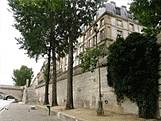 Currently, the island’s existence is both contrasting and paradoxical. While the surrounding banks explode with city life, mobs of people, and avenues congested with traffic, the island seems to escape this hustle and bustle, resembling a small town rather than a booming metropolis. At the same time, the island remains at the historical, cultural, and physical centre of Paris, only minutes from some of the most well known monuments, museums, and places of interests. Ile Saint-Louis is both at the very heart of the city and removed from it in mentality.
Currently, the island’s existence is both contrasting and paradoxical. While the surrounding banks explode with city life, mobs of people, and avenues congested with traffic, the island seems to escape this hustle and bustle, resembling a small town rather than a booming metropolis. At the same time, the island remains at the historical, cultural, and physical centre of Paris, only minutes from some of the most well known monuments, museums, and places of interests. Ile Saint-Louis is both at the very heart of the city and removed from it in mentality.
Those that come to this unique place range in their characteristics from humble to bourgeois, French to international. They are both tourists and long-time, permanent residents. All those who come are drawn there because of its exceptional history, charm, and tranquillity. A package that has delighted for centuries and will surely continue to do so well into the future.
For any availability request, please kindly use the following form Availability Request.
For any other information, please use the contact form or send us an email directly to [email protected]
Our dedicated team looks forward to hearing from you.




